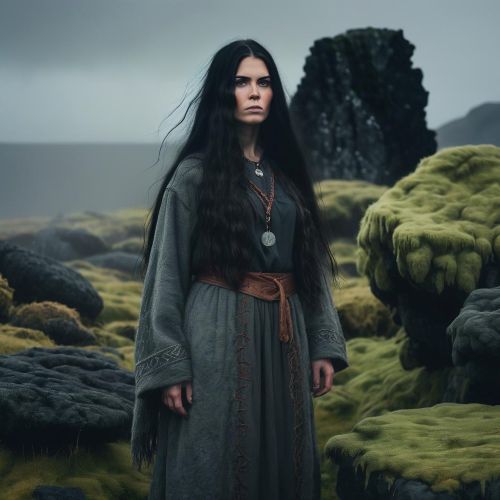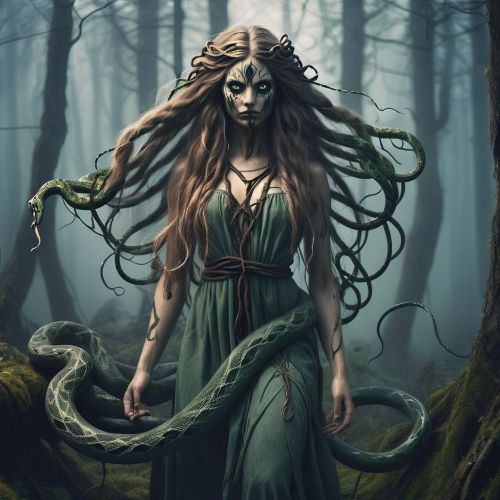Northern European Spirits
Northern European Spirits are some of the most captivating figures in the folklore of Finnish, Sámi, Icelandic, Estonian, and Norse traditions. Unlike gods or mortals, these beings existed in the spaces between, often tied to nature, ancestors, or the unseen world. Spirits shaped everyday life, influencing harvests, hunts, journeys, and family well-being. They were both protectors and tricksters, guardians of sacred spaces or reminders of the consequences of disrespect. In mythology, spirits embody the belief that the natural world was alive with forces beyond human control, weaving a powerful connection between people and their surroundings.
In Finnish mythology, spirits of the dead and of nature were central to belief. Ancestors were thought to linger near their descendants, protecting households and guiding communities when properly honored. Forest spirits, water nymphs, and household beings played active roles in daily life, demanding offerings in exchange for safety or prosperity. The Finnish view of spirits emphasized reciprocity, where humans and unseen beings relied on each other to maintain balance and harmony.
Sámi traditions place great importance on spirits connected to nature and the practice of shamanism. The noaidi, or shaman, acted as an intermediary, communicating with animal and ancestral spirits through ritual journeys. Spirits of reindeer, rivers, and winds carried immense significance, shaping survival in the Arctic landscape. Some Sámi stories also tell of mischievous spirits who tested hunters and travelers, ensuring respect for sacred laws. This worldview revealed the Sámi understanding that spirits were woven into the fabric of existence, guiding and challenging humanity in equal measure.
In Norse and Icelandic traditions, spirits appear in many forms, from landvættir (land spirits) to guardian beings tied to farms and households. These entities were believed to protect regions, influencing the prosperity of entire communities. Icelandic sagas describe encounters with spirits who warned of dangers or punished those who disturbed sacred places. Norse cosmology also included spirits of the elements and the dead, underscoring the belief that every corner of the world was alive with hidden power.
Estonian folklore similarly abounds with stories of spirits tied to water, forests, and household spaces. Näkk, a water spirit, could appear in many forms, luring the unwary into lakes and rivers, while other beings guarded crops, animals, or family life. Spirits were seen not as distant forces but as ever-present companions, capable of blessing or cursing depending on human actions. Their presence in Estonian belief mirrored the region’s deep respect for natural landscapes and the invisible life within them.
Across Finnish, Sámi, Icelandic, Estonian, and Norse traditions, Northern European Spirits reflect a worldview where every tree, river, and mountain held unseen power. These beings continue to inspire folklore, literature, and cultural practices, reminding us of humanity’s enduring relationship with the invisible world. Their stories emphasize respect for nature, reverence for ancestors, and the recognition that the spiritual world is always close, shaping the destiny of mortals and gods alike.
Northern European Spirits are some of the most captivating figures in the folklore of Finnish, Sámi, Icelandic, Estonian, and Norse traditions. Unlike gods or mortals, these beings existed in the spaces between, often tied to nature, ancestors, or the unseen world. Spirits shaped everyday life, influencing harvests, hunts, journeys, and family well-being. They were both protectors and tricksters, guardians of sacred spaces or reminders of the consequences of disrespect. In mythology, spirits embody the belief that the natural world was alive with forces beyond human control, weaving a powerful connection between people and their surroundings.
In Finnish mythology, spirits of the dead and of nature were central to belief. Ancestors were thought to linger near their descendants, protecting households and guiding communities when properly honored. Forest spirits, water nymphs, and household beings played active roles in daily life, demanding offerings in exchange for safety or prosperity. The Finnish view of spirits emphasized reciprocity, where humans and unseen beings relied on each other to maintain balance and harmony.
Sámi traditions place great importance on spirits connected to nature and the practice of shamanism. The noaidi, or shaman, acted as an intermediary, communicating with animal and ancestral spirits through ritual journeys. Spirits of reindeer, rivers, and winds carried immense significance, shaping survival in the Arctic landscape. Some Sámi stories also tell of mischievous spirits who tested hunters and travelers, ensuring respect for sacred laws. This worldview revealed the Sámi understanding that spirits were woven into the fabric of existence, guiding and challenging humanity in equal measure.
In Norse and Icelandic traditions, spirits appear in many forms, from landvættir (land spirits) to guardian beings tied to farms and households. These entities were believed to protect regions, influencing the prosperity of entire communities. Icelandic sagas describe encounters with spirits who warned of dangers or punished those who disturbed sacred places. Norse cosmology also included spirits of the elements and the dead, underscoring the belief that every corner of the world was alive with hidden power.
Estonian folklore similarly abounds with stories of spirits tied to water, forests, and household spaces. Näkk, a water spirit, could appear in many forms, luring the unwary into lakes and rivers, while other beings guarded crops, animals, or family life. Spirits were seen not as distant forces but as ever-present companions, capable of blessing or cursing depending on human actions. Their presence in Estonian belief mirrored the region’s deep respect for natural landscapes and the invisible life within them.
Across Finnish, Sámi, Icelandic, Estonian, and Norse traditions, Northern European Spirits reflect a worldview where every tree, river, and mountain held unseen power. These beings continue to inspire folklore, literature, and cultural practices, reminding us of humanity’s enduring relationship with the invisible world. Their stories emphasize respect for nature, reverence for ancestors, and the recognition that the spiritual world is always close, shaping the destiny of mortals and gods alike.



